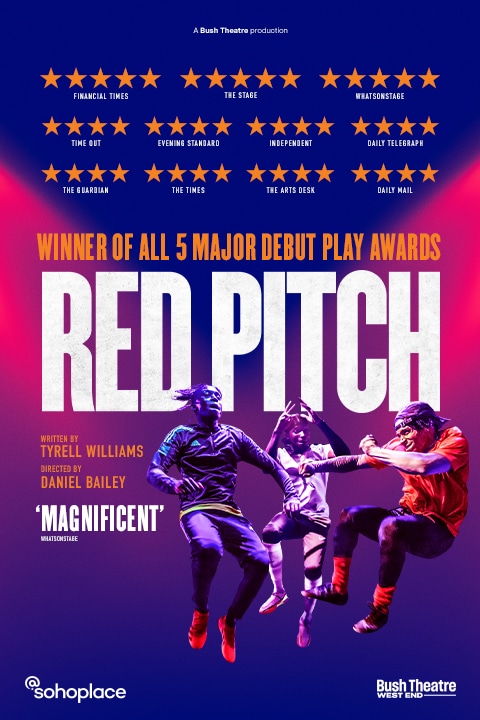This month I took a trip to @SohoPlace theatre in the heart of London’s West End. It was my third visit to the only theatre in London that is completely accessible to disabled actors, and because of this and the incredible productions that it houses, I will always support it. This time I watched Red Pitch, a play addressing the gentrification of deprived areas and the people who are left behind in the name of ‘progress’.
It’s a coming-of-age story about three Black boys navigating masculinity, friendship and chosen family set their beloved council estate football pitch, which is under threat of being destroyed along with their flats under a government regeneration project.
We all have our own Red Pitch
Mine was Maesglas park, a field that all children from the ex-council estate would gather to play our hybrid game of football, cricket and rounders. I remember playing it so much one summer that the worn grass faded to brown on the starting spot, matching our muddy joggers. It was our first taste of independence, figuring out the dynamics of a world without parents in the safety of a park just down the road from home.
For the boys in the play, heavy conversations of family relocation and the realities of being a young carer are littered amongst the all-important upcoming football trials and their determination to become successful. In fact some of the most profound moments in the play take place when a ball is being kicked from one character to another because the threat of eye contact makes it all the more real. Not only is the theme of football as escapism written throughout Tyrell Williams’ script as the characters’ way out of the estate but Daniel Bailey’s direction demonstrates that it is the boys’ catalyst for communication.

Breaking elitist barriers
In the last few decades theatre has become elitist. Despite its conception being rooted in working-class culture – remember when the gentrified had to ‘dress down’ to enter Shakespeare’s globe to watch his performances because the theatre was not for them – theatre has taken a full 180.
With tickets at an extortionate price and drama being pushed out of state-school education, most working-class people will never step a foot in a theatre let alone enjoy performances. And if marginalised communities don’t feel reflected in the stories or respected in the spaces then why would they go? Which just creates the self-fulfilling prophecy that theatre is only for White people.
Let me qualify this. We go to the theatre a lot (we don’t have kids so our disposable income goes on theatre tickets) and my partner is oftentimes the only brown person in the audience. This is felt even more so in the theatre land of London’s West End.
But when we sat in the audience of Red Pitch, the room was filled with Black and Brown faces and the standing ovation at the end was definitely heartfelt. You could sense the ‘about bloody time’ in the air. We need more Black characters on stage that aren’t Othello, we need more stories that centre the Black and Brown experience that isn’t limited to period pieces on slavery, we need more Black and Brown characters who *spoiler alert* don’t get stabbed or arrested, we need more Black and Brown actors on the West End stage to show their community that the arts is for them.
Role models
The performances of Kedar Williams-Stirling and Francis Lovehall were beautiful, capturing the bitter sweetness of Williams’ words. Being able to embody the complex array of cockiness and competitive confidence of young men yet the fear and insecurity of the boys that they still are.
But for me the standout performance lies with Emeka Sesay who played the level-headed goalie, Joey. His code-switching from gentrified shop owner to Nigerian elder was masterfully done, demonstrating a flare for comedy timing and the two worlds that his character straddles. And Sesay has a special connection to the play, having grown up playing on the very same pitch that the play itself is set.
It’s a big responsibility bringing a new play to the West End stage, especially when it is your theatre debut but this is part of a bigger message for Sesay, saying in an interview: ‘I hope the people we’re talking about in the show get to come here. To know they don’t have to wave at us from afar and say good luck – they actually belong.’

The Big House
Feeling like an outsider at the beginning of his career, Sesay’s time at The Big House – a charity transforming the lives of care leavers and at-risk young people through the arts – felt like true acceptance.
Despite only 1% of children in the UK having been in care, 40% of youth offenders and 70% of sex workers have a care background which just shows that the system is broken.
Founder of The Big House, Maggie Norris, not only recognised the problem but created a solution, with 80% of the young people participating in her 12-week Open House Project going onto education, employment and further training.
The Big House Means Business Project also provides employment opportunities for members to facilitate workshops and performances with the view to educate audiences and corporations on topics such as ‘empathy & difficult conversations’, ‘County Lines / Keeping young people safe’ and Equality, Diversity and Inclusion.
Flipping the Script
Theatre is much more than entertainment, it is about identity and reflection. By giving audiences a glimpse into the lives of individuals we can see the world anew, explore real issues in a safe ‘make believe’ world and possibly enact change.
It is through theatre that The Big House is changing the lives of the young people that our society has failed and it is through theatre that Emeka Sesay, Francis Lovehall and Kedar Williams-Stirling become the role models for future generations. Showing that without an existing path you can create a brand new route that is purpose built for you.
Red Pitch is playing @sohoplace until 4th May 2024 – you can get your tickets here:
https://sohoplace.org/shows/red-pitch
Learn more about The Big House’s ethos and how you can support the charity here
This Blog was written by Ella Peel, our Inclusion and Diversity Lead

